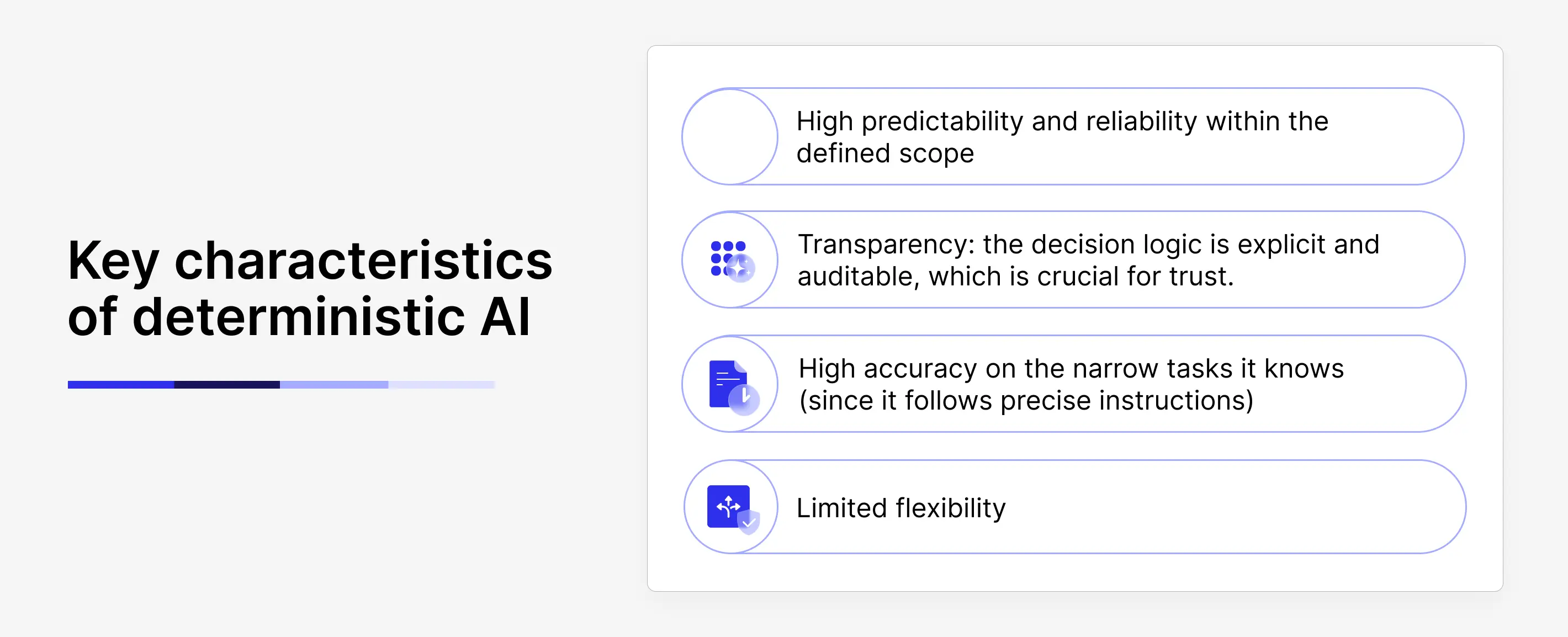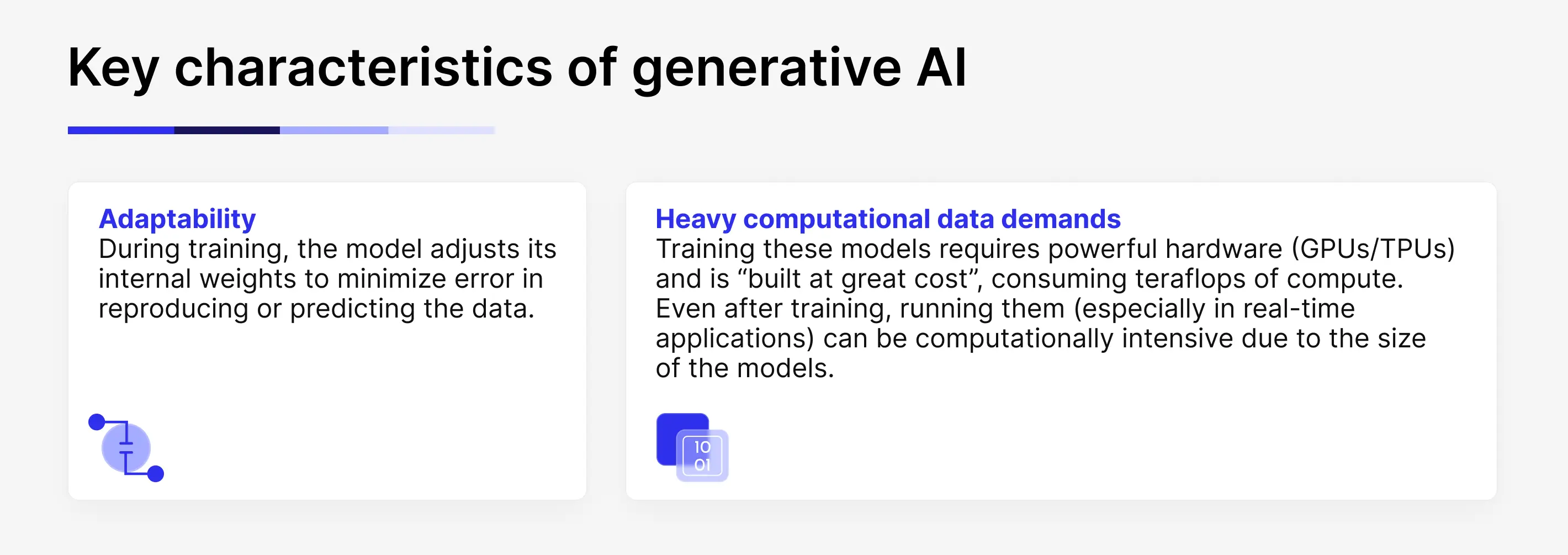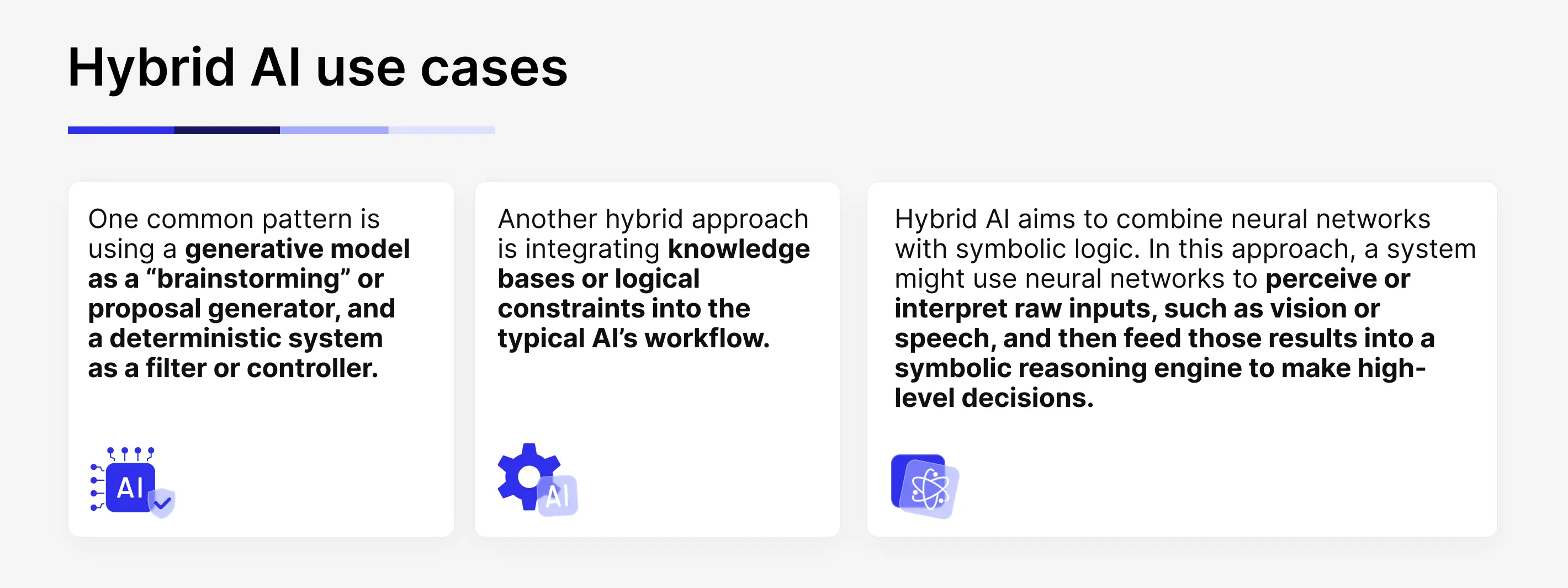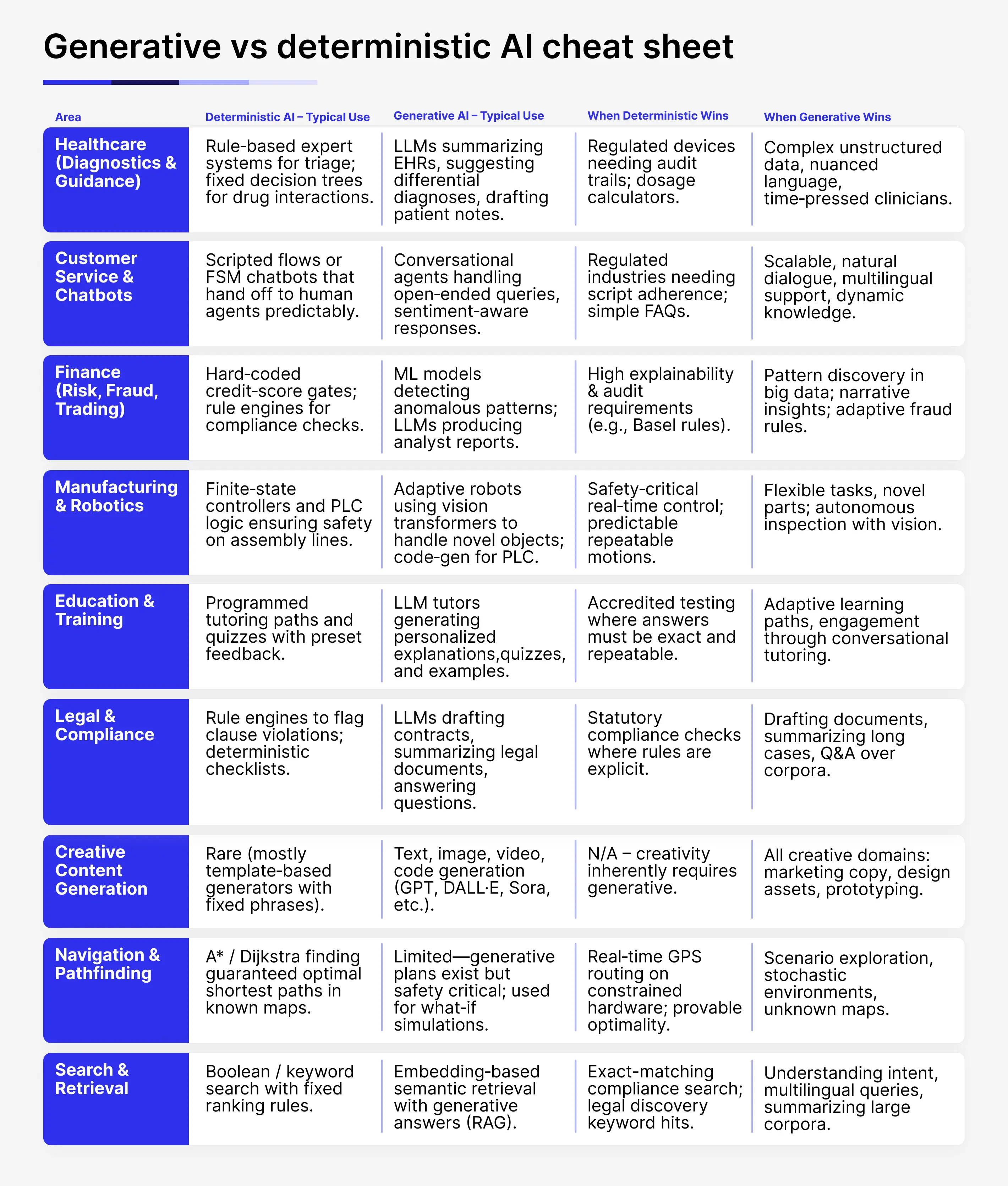“In the fast-paced, evolving world…” Unfortunately, for the average user, this AI-overused opening ironically explains the idea of artificial intelligence. Hopefully, it encompasses dozens of concepts rather than tedious writing, and today we’ll discuss one of them. Hopefully, it encompasses dozens of concepts rather than tedious writing, and today we’ll discuss one of them. The most conservative. The most regulated. And the most… contrived, according to some opinions. It’s Deterministic AI.
In this piece, we’ll explore what’s behind this concept, what defines its role in the modern AI landscape, and how to combine it with other approaches to build an effective, well-rounded Hybrid AI system.
What is deterministic AI?
Simple answer: Deterministic AI can be described as a good old rule-based system that operates only through fixed rules and logic defined by humans.
Longer and more complicated answer: Deterministic AI is a concept when there is no randomness in the decision process. In other words, this is a system where the same conditions always trigger the same result. This predictable behavior stems from the previously mentioned rule-based architecture. The AI’s knowledge and decision criteria are explicitly coded as if-then rules, decision trees, or logical statements.

Early symbolic AI and expert systems exemplify this approach. They employed formal logic and explicit rules to simulate human decision-making, with domain experts encoding their knowledge into the system. For example, an expert system for loan approval might contain a rule like: IF applicant_age ≤ 50 AND income ≥ $60k THEN approve loan. The system strictly follows such rules, ensuring “rock-solid predictability”.
How deterministic AI works?
Deterministic AI generally comprises a knowledge base (which includes rules and facts) and an inference engine that applies these rules to input data. Techniques used in this field include: decision trees, which branch on conditions to reach conclusions; expert systems, which consult a coded knowledge base of domain rules; and other logic-driven algorithms (from simple rule scripts up to formal logic solvers).
There is no learning from new data in a deterministic system – its intelligence is entirely in the programmed logic. The advantage is that every step of reasoning is transparent: developers and users can clearly trace the reasons behind the system’s decisions by examining the sequence of rules that were activated. This transparency was a defining characteristic of expert systems in the 1970s and 1980s. Before the rise of AI, these systems emulated human experts by utilizing if-then rules and were able to articulate their reasoning in a way that was understandable to humans.
Key characteristics of deterministic AI
As we mentioned, Deterministic AI never “makes things up” or deviates beyond what it’s programmed to do. This means high predictability and reliability within the defined scope – e.g. a calculator always outputs 4 for 2+2, or a rule-based chatbot always gives the same response to an identical query. It also means transparency: the decision logic is explicit and auditable, which is crucial for trust. For instance, a compliance checker can explicitly log which rule caused it to flag a transaction. Accuracy is high on the narrow tasks it knows (since it follows precise instructions), but flexibility is very limited.

A deterministic system cannot handle scenarios if it wasn’t coded for. This indicates that any input outside its rules leads to failure or a default output. It cannot learn new patterns autonomously or adapt to changing data. As one of the Sombra Team Leads noted, “The rules are both a blessing and a curse for these systems.” Each modification must be hand-coded by humans, which can be labor-intensive if the domain expands.
Use cases for deterministic AI
Here are some classic examples to use such systems:
- Business rule engines. For example, to use in repricing in big retail chains.
- Robotic Process Automation (RPA) for repetitive tasks (e.g. processing forms with set logic)
- Finance and compliance – e.g. enforcing regulatory rules, flagging transactions that violate threshold conditions
- Medical expert systems that apply established clinical guidelines to diagnose (ensuring consistency with medical rules; an
- Game AIs for non-player characters using scripted behavior. In such applications, outcomes must be consistent and explainable, and the environment doesn’t change drastically.
Of course, these are only a few examples, and each client case is unique. If you’re looking for something tailored to you, check out Sombra’s AI and ML services.
What about a new kid on a block?
If you compare deterministic AI to the latest concepts, you’ll see just how far technology has advanced. Yes, we know that by now, everyone and their dog has written about Generative AI (we have too, by the way). But without a quick comparison of the two, this article wouldn’t be complete.

Generative AI represents a paradigm where the AI model learns from data and can produce novel outputs that were never explicitly programmed. These systems rely on probabilistic, statistical learning rather than fixed human-authored rules. That means that generative models analyze vast training datasets to internalize patterns and then generate new data that follows those learned patterns. For example, a generative image model trained on thousands of dog photos learns the abstract features of dogs (shapes, textures) and can then synthesize a completely new dog image that isn’t a copy of any training photo. Similarly, a large language model like GPT is trained on billions of words of text and can generate new paragraphs or code by probabilistically predicting the next token in a sequence, based on patterns learned from human-written text.
Under the hood, these systems use deep neural network architectures (such as transformer networks for text or diffusion models for images). These networks have many layers of artificial neurons that automatically learn hierarchical features from the data. During training, the model adjusts its internal weights to minimize errors in reproducing or predicting the data. The result is a complex statistical model that can sample new outputs. This makes generative AI extremely adaptable – it can generalize to inputs it hasn’t seen before by drawing on similar patterns from training.
In essence, generative AI “does not simply apply rules but learns from vast datasets to create novel and contextually relevant outputs”, making it suitable for open-ended tasks requiring creativity or pattern synthesis.

However, the power of generative models comes at the cost of heavy computational and data demands. Training these models requires powerful hardware (GPUs/TPUs) and is “built at great cost”, consuming teraflops of computing. Even after training, running them (especially in real-time applications) can be computationally intensive due to the size of the models. In contrast, deterministic algorithms usually have modest runtime requirements.
In practical terms, a rule-based system might run on a simple server or even a microcontroller, while a generative model might need a cluster of machines or specialized AI chips for training and deployment.
Deterministic vs generative AI
The main differences between the concepts and their approaches can be summarized in a few key points.
Explainability
Generative AI models are inherently opaque—often called “black boxes”—since their decisions rely on complex numeric weights rather than human-readable rules. While these models can handle nuance and ambiguity well, their lack of transparency poses issues for trust and regulatory compliance, especially in high-stakes fields like healthcare or finance. By contrast, deterministic AI is fully transparent, as decisions follow explicit rules that can be audited and adjusted directly.
Capabilities
Generative AI excels in creativity and adaptability, generating original, contextually appropriate content like text, images, code, or designs. Unlike deterministic systems that fail if input doesn’t match predefined rules, generative models manage ambiguous queries by learning from patterns in large datasets. They adapt automatically to new training examples, making them ideal for evolving tasks or environments.
Use Cases
Generative AI thrives where creative or complex automation is needed—writing, graphic design, code generation (e.g., GitHub Copilot), drug discovery, personalized recommendations, and anomaly detection. Deterministic AI is ideal for tasks that require consistency and clear audit trails, such as robotic process automation, rule-based fraud detection, compliance checks, clinical decision support, and deterministic chatbots that provide predictable responses.
Transparency and Regulation
Deterministic AI’s explicit rule-based logic simplifies auditing, regulatory compliance, and maintainability. Changes involve direct rule adjustments, ensuring predictable outcomes and easy validation. Generative AI, however, requires extensive testing and monitoring to detect biases or unexpected behaviors, complicating compliance and regulatory approval. Mitigation strategies often combine generative models with explainability tools (like LIME or SHAP) or deterministic oversight.
Scalability and Adaptability
Generative models handle complex, high-dimensional, and unstructured data better than deterministic AI. They generalize from learned patterns, making them suitable for dynamic scenarios requiring rapid adaptability (e.g., customer interactions or evolving fraud patterns). Deterministic systems are rigid, necessitating manual updates as environments change. While deterministic AI ensures predictable, consistent results, generative models are flexible across tasks and domains, though with occasional inconsistencies or inaccuracies.
A related point is the handling of unstructured or noisy data. Generative models can digest raw data (like all the raw text on Wikipedia or images from the web) and make sense of it. Rule-based systems typically require structured input, such as a defined set of attributes. They struggle with raw sensory data because there are no straightforward rules to map pixels to concepts without a learning process.
Testing, Deployment, and Maintenance
Testing deterministic systems is straightforward—outputs are consistent, making validation simple and predictable. Generative models, conversely, require statistical testing and adversarial checks due to variability and potential unpredictability. Deployment speed favors deterministic approaches when rules are clear, whereas generative models need substantial data collection and training but scale faster once established. Handling data drift involves retraining for generative AI and rule updates for deterministic systems, each with associated maintenance costs.
Choose deterministic AI when transparency, regulation, consistency, and predictability are paramount. Opt for generative AI when tasks are creative, complex, rapidly evolving, or require nuanced adaptability and generalization.
Hybrid systems: combining deterministic and generative approaches
And finally, the most interesting part. As you can see, even as the grandfather of modern models, deterministic AI is far from obsolete. If we manage to combine the strengths of both concepts discussed in this piece, we get what’s now commonly referred to as a hybrid system.

The goal is to leverage generative AI’s creativity and learning capacity, while keeping the reliability and clarity of deterministic logic as a guardrail. These hybrid designs acknowledge that not every problem is best solved by one approach alone. Often the optimal solution uses them in tandem, each covering the other’s weaknesses.
One common pattern is using a generative model as a “brainstorming” or proposal generator, and a deterministic system as a filter or controller. For example, consider code generation: a generative AI (like an LLM trained on code) can write candidate code for a given feature much faster than a human. However, AI might hallucinate. A hybrid solution is to have the AI generate code, then pass it through a deterministic rule-based checker that enforces known requirements (security guidelines, syntax rules, style conventions). The deterministic module can reject or modify any parts of the AI’s output that violate the rules, ensuring the final code meets all criteria.
This way, the AI provides creativity and productivity, and the rule-based system provides precision and compliance. It is a powerful best-of-both-worlds strategy. The generative part might suggest 10 solutions, the deterministic part picks the ones that are valid.
At Sombra, we see this concept as broadly applicable to most clients who want to use AI in their work at its best: an AI could draft an analytical report in natural language, and a deterministic component could verify that all figures cited in the report match the official database (flagging any “hallucinated” stats). In design, an AI might generate a bunch of engineering blueprints, and a rule-based system checks each against physical laws or safety regulations, rejecting designs that don’t meet standards.
Another hybrid approach is integrating knowledge bases or logical constraints into the typical AI’s workflow. For example, a retrieval-augmented generation or RAG, where an LLM (generative) is paired with a deterministic search over a knowledge database. When asked a factual question, the system first deterministically fetches relevant documents (using keywords or a vector similarity search), and then the generative model composes an answer using that retrieved information. The deterministic part grounds the generative part in real data, greatly reducing the chances of incorrect “hallucinations” and improving factual accuracy.
A specific instance of this is using knowledge graphs (a very deterministic, structured representation of facts) alongside LLMs: the LLM might convert a query into a structured form, query the knowledge graph for precise info, and then produce a fluent answer. For instance, you can read about Microsoft’s GraphRAG approach. The result is a more trustworthy AI system – you get the fluency and flexibility of generative models, but with grounded, verifiable data injected by deterministic means.
Hybrid AI is emerging in a field known as neuro-symbolic AI research, which aims to combine neural networks with symbolic logic. In this approach, a system might use neural networks to perceive or interpret raw inputs, such as vision or speech, and then feed those results into a symbolic reasoning engine to make high-level decisions.
This can be observed in some robotics applications: a robot uses deep learning for object recognition in its environment (this is known as generative pattern recognition) but then plans its actions with a rule-based planner that ensures safety—such as avoiding spills or collisions with humans. The neural component allows for adaptability to real-world variability, while the symbolic component ensures adherence to rules and provides a logical explanation for the robot’s decisions.
The benefits of hybrid systems are increasingly evident. Capgemini’s AI lab noted that “the precision and interpretability of deterministic AI” can be combined with “the flexibility and adaptability of statistical (generative) AI”to handle complex tasks with both structure and uncertainty. In their example, a fraud detection system utilized a knowledge graph, consisting of symbolic rules about relationships, along with a machine learning model. This combination produced an interpretable solution that also achieved high accuracy.
What’s next?
A lot of experts said that the future of AI likely lies in such integrated approaches, leveraging the strengths of both deterministic and generative methods. By doing so, we can achieve solutions that are both innovative and reliable – for example, an AI assistant that is as creative and fluent as ChatGPT, but with the factual accuracy and consistency of a rules database.
According to the Innovation Guide for Generative AI Technologies by Gratner, companies are currently promoting solutions that “ground generative AI in truth” by utilizing deterministic knowledge bases. They emphasize that achieving “100% explainability” through a deterministic layer combined with the capabilities of generative AI is ideal for enterprises.
Of course, everything described above is just the tip of the iceberg, and combining different models, like playing a good RPG game, can be done in a hundred different ways. That’s why it’s best to consult with AI professionals and design an architecture that truly fits your needs.
Final tip
You might have expected a conclusion here. Instead, we would like to provide a quick cheat sheet to help you determine when to use each approach. It’ll solidify your understanding of the difference between deterministic and generative methods.
Here you go.












